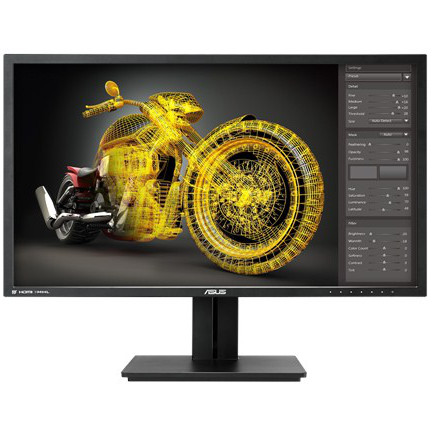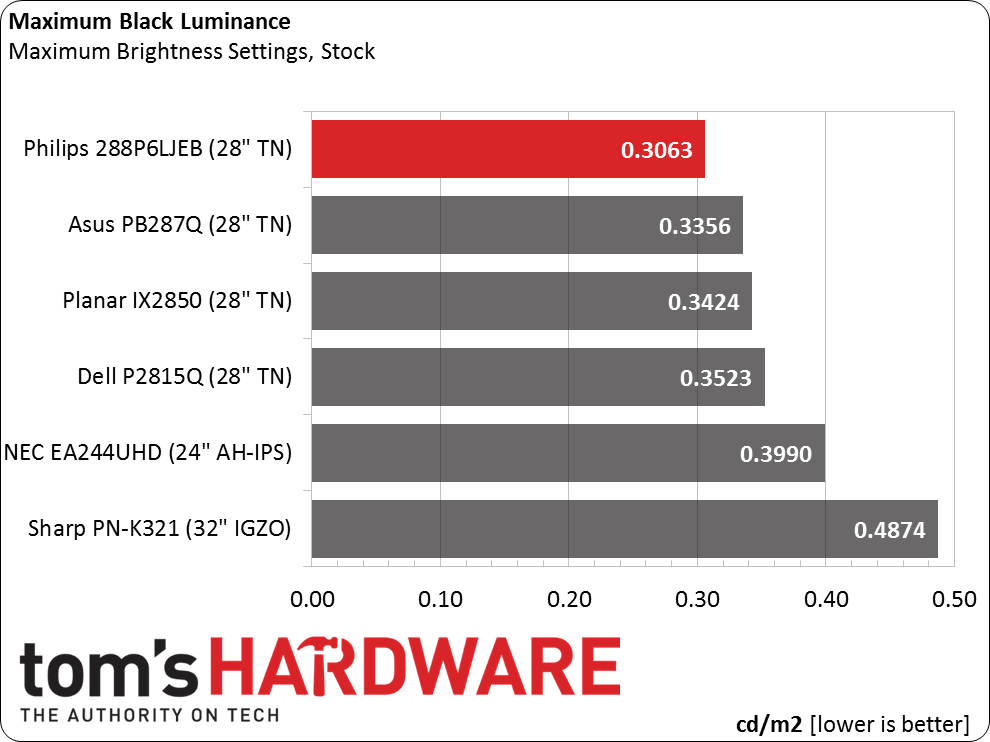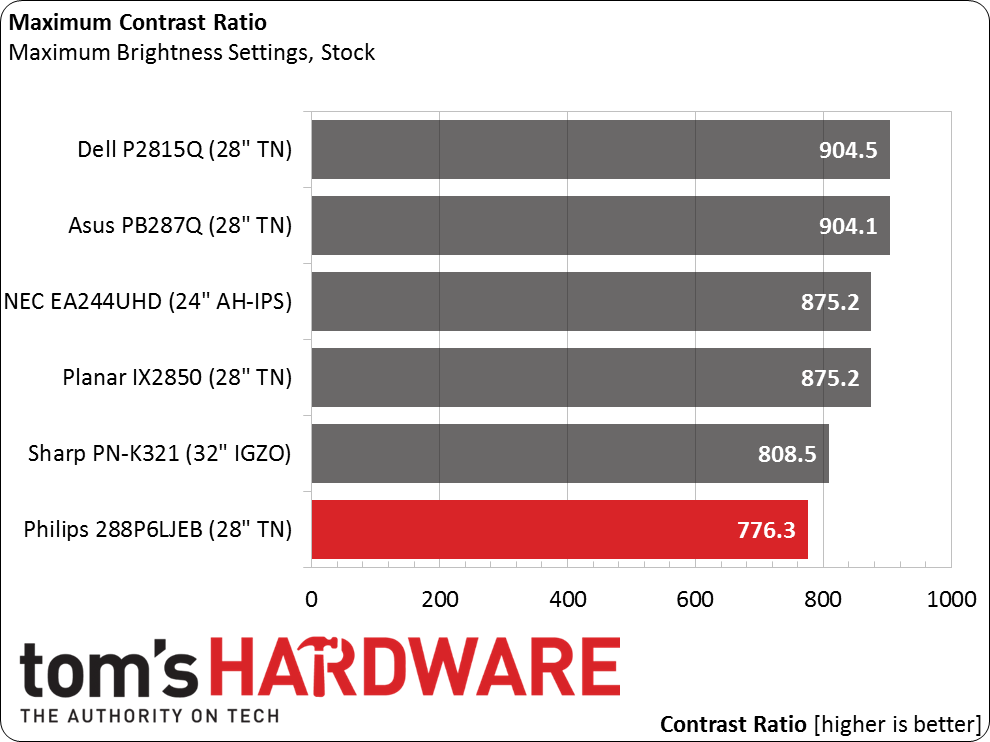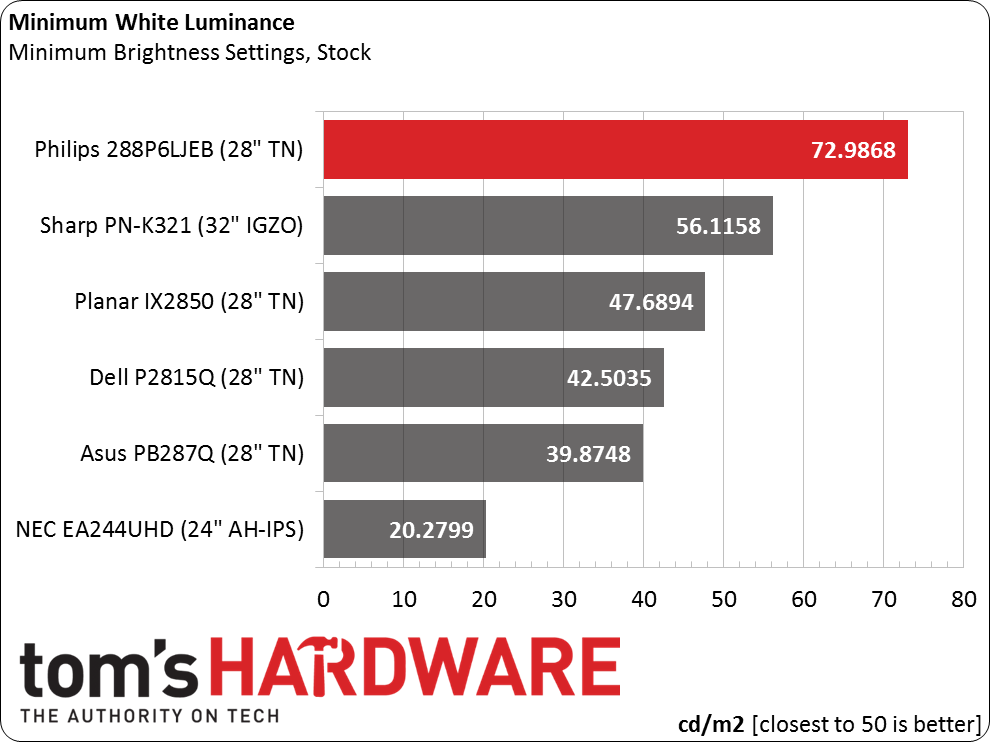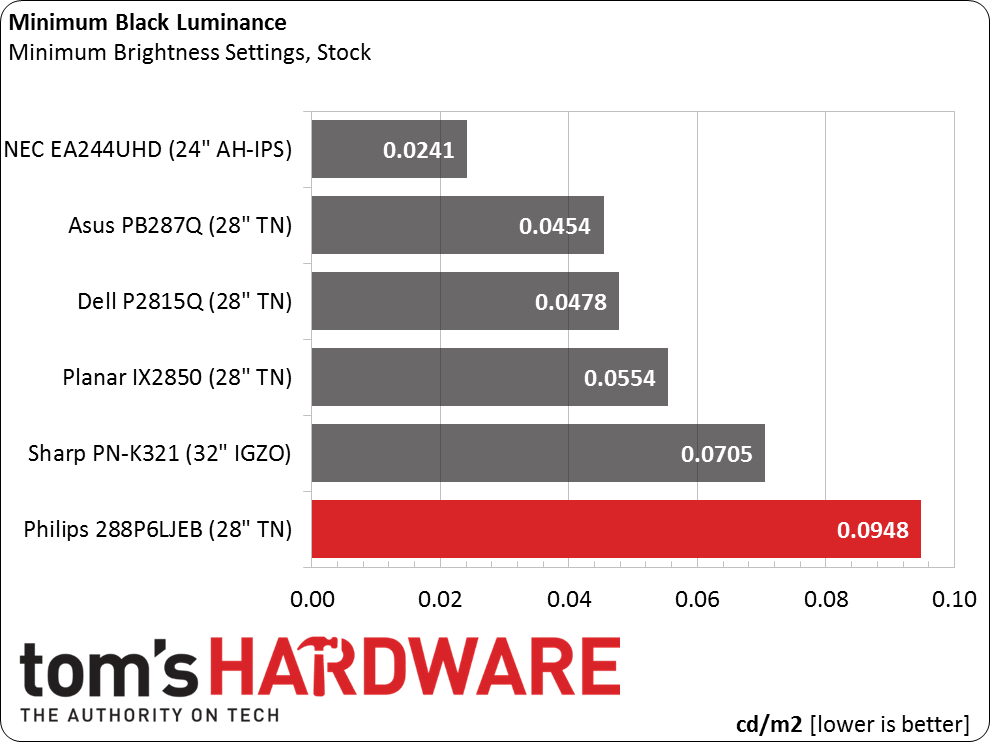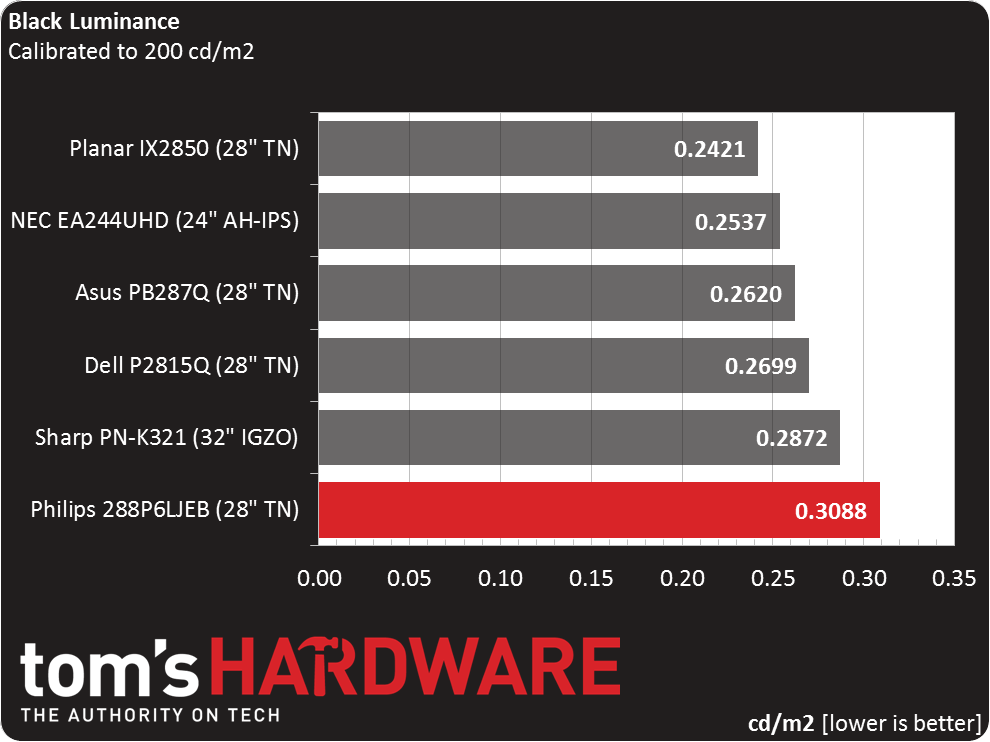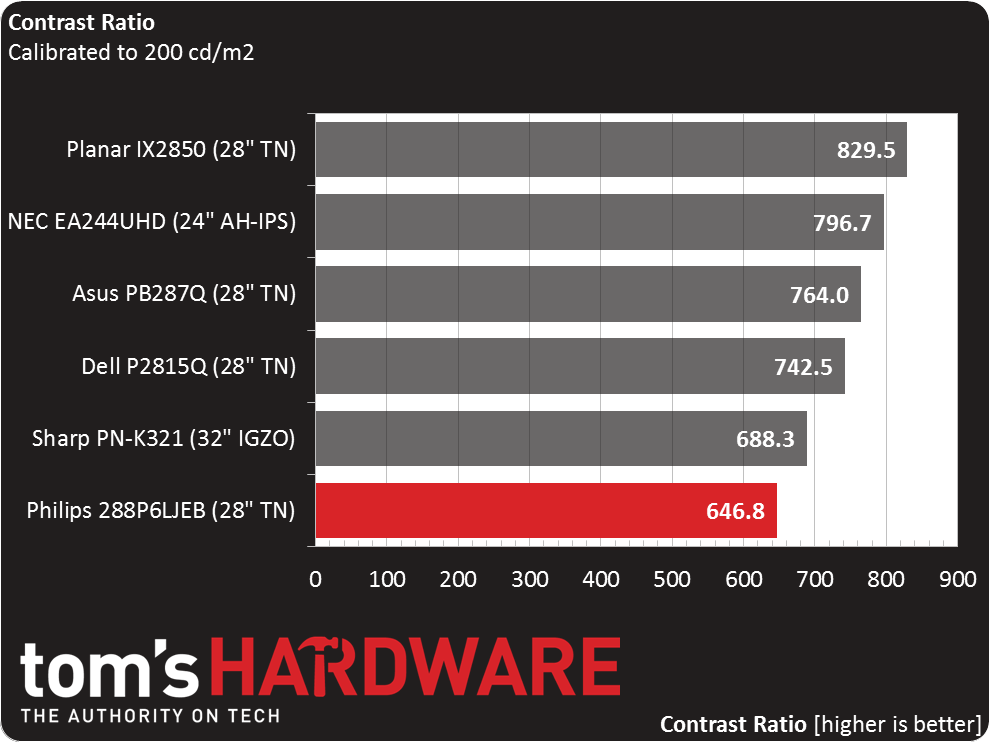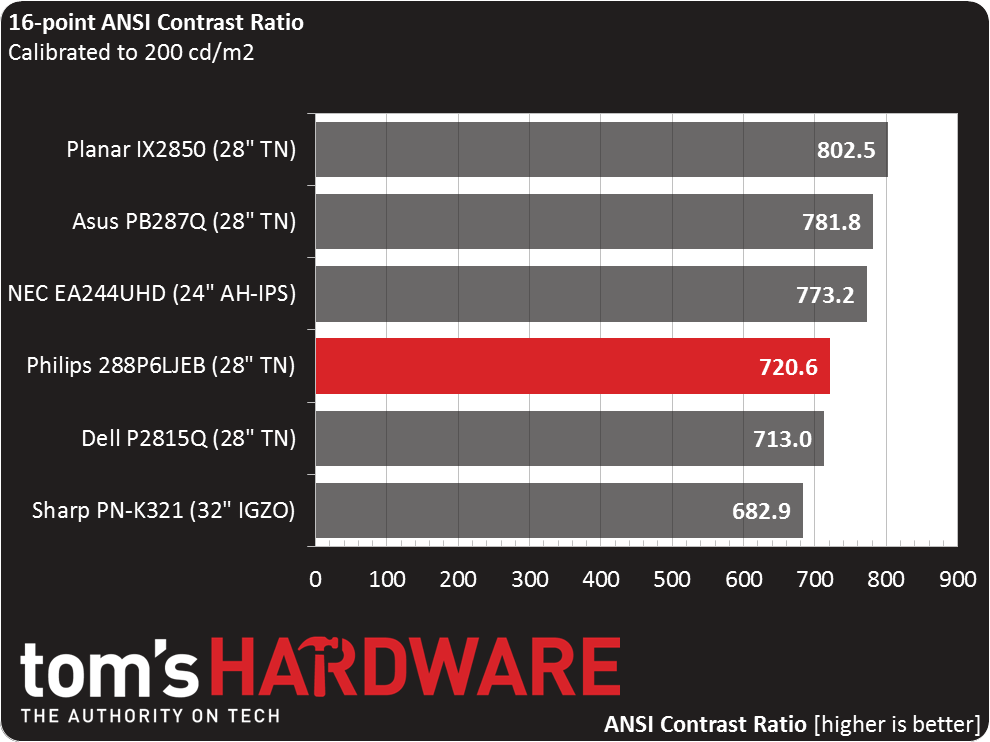Philips 288P6LJEB 28-Inch Ultra HD Monitor Review
We're hard at work reviewing every 4K screen we can get our hands on so that you know which one is best. With our evaluation of Philips' 288P6LJEB, only one available monitor remains. How does this 28" Ultra HD display size up to its competition?
Why you can trust Tom's Hardware
Results: Brightness And Contrast
To read about our monitor tests in-depth, please check out Display Testing Explained: How We Test Monitors and HDTVs. Brightness and Contrast testing is covered on page two.
Uncalibrated – Maximum Backlight Level
Today’s comparison group includes three other TN-based Ultra HD screens: Asus’ PB287Q, Dell’s P2815Q and Planar’s IX2850, which we reviewed a couple of weeks ago. Rounding out the charts are Sharp’s PN-K321 32-inch IGZO model and the excellent NEC EA244UHD 24-inch IPS display.
We were a bit surprised at the low maximum output number generated by the 288P6LJEB. As you can see, the other displays hit at least 300cd/m2, which is also supposed to be Philips' rating. We tried the other SmartImage modes, but found no additional light. While this won’t be a problem in a typical workspace, there isn’t enough brightness available for an outdoor location or a sunlit office.
Not surprisingly, the low backlight level means that Philips shows off the best maximum black level. Unfortunately, it does not mean you also get the best contrast.
A measurement of 776.3 to 1 is not the lowest contrast we’ve recorded for an Ultra HD screen. That distinction belongs to Dell's UP2414Q. It is lower than we’d like, however. Among the $600 4K screens, Dell and Asus have the largest dynamic range and therefore a little more pop than Philips.
Uncalibrated – Minimum Backlight Level
The 288P6LJEB’s backlight goes down to a perfectly usable 72.9868cd/m2. We’d prefer it to be closer to 50cd/m2, but 73-ish is still a good setting to use in darkened rooms. The 100-step brightness control has very fine resolution, so if you’re shooting for a particular number, it’s easy to hit it precisely.
Given the contrast numbers we’re seeing so far, we weren’t expecting a great black level result. It’s exacerbated by the higher-than-average minimum white level.
Get Tom's Hardware's best news and in-depth reviews, straight to your inbox.
Minimum contrast is within a whisker of the maximum value, so the Philips is consistent at the very least. This is our ninth Ultra HD monitor review to date, and so far it seems that only Dell's UP3214Q tops a contrast ratio of 1000 to 1. Our hope is that next-gen AMVA panels will include 4K resolution so we can see ratios closer to 2000:1.
After Calibration to 200cd/m2
Calibrating the 288P6LJEB exposed a few obstacles, especially with regards to the contrast control. For that reason, we took a hit to overall contrast by adjusting the white balance and gamma controls. While a black level of .3088cd/m2 isn’t bad, it is the highest we’ve seen thus far from an Ultra HD display.
The calibrated contrast is correspondingly low at 646.8 to 1. We had to drop the contrast slider 12 clicks to correct grayscale issues at the 90- and 100-percent levels. This is a display where you have to decide whether to maximize contrast or achieve optimum accuracy throughout the entire brightness range.
ANSI Contrast Ratio
It’s rare that any monitor returns an ANSI contrast result higher than its calibrated one. We’re happy to see this because it means the 288P6LJEB’s image is of far higher quality than its on/off contrast results would indicate. After looking at all the numbers, we’d say the backlight control is where Philips stumbled a bit. If it could go a little brighter and return a slightly better black level, it would be perfect. There is obviously no problem with the panel’s grid polarizer, given the ANSI value.
Current page: Results: Brightness And Contrast
Prev Page OSD Setup And Calibration Of The Philips 288P6LJEB Next Page Results: Grayscale Tracking And Gamma Response
Christian Eberle is a Contributing Editor for Tom's Hardware US. He's a veteran reviewer of A/V equipment, specializing in monitors. Christian began his obsession with tech when he built his first PC in 1991, a 286 running DOS 3.0 at a blazing 12MHz. In 2006, he undertook training from the Imaging Science Foundation in video calibration and testing and thus started a passion for precise imaging that persists to this day. He is also a professional musician with a degree from the New England Conservatory as a classical bassoonist which he used to good effect as a performer with the West Point Army Band from 1987 to 2013. He enjoys watching movies and listening to high-end audio in his custom-built home theater and can be seen riding trails near his home on a race-ready ICE VTX recumbent trike. Christian enjoys the endless summer in Florida where he lives with his wife and Chihuahua and plays with orchestras around the state.
-
envy14tpe It seems as though this is a 4k gaming monitor but I don't think that really lives up to the demand for fast fps gaming. 2160p sounds great but if its lag isn't that good it loses out to the 1440p 144Hz Asus PG278Q monitor. That seems more appropriate for gaming.Reply
I know this review is about 4k gaming but I'd like to see how the speed of a 1440p compares. There is a tradeoff when you take resolution over speed. -
ubercake Great review.Reply
If I'm looking in the $799 price range, I'm looking for higher-than-1080p resolutions and I'm either looking for the color accuracy of an IPS or PLS monitor for work purposes or I'm looking for TN gaming performance.
Since this is a TN monitor, we need to consider gaming performance. No G-sync at $799 retail? I can get the Acer 4K 60Hz with G-sync for this price or less. That's just too much for this Philips, but the Amazon price of around $580 seems closer to the target. Further, if a monitor is not using G-sync or a high refresh rate (120Hz+), I definitely wouldn't consider it for gaming. $580 might be worth simply upgrading to 4K though if you're on a 60Hz, but the contrast on this monitor kind of stinks.
Also, I'm not looking for color accuracy in a TN monitor. If I want color accuracy for matching print to screen colors, I'm looking at IPS or PLS options. On the other hand, when looking for a good TN monitor for gaming, you want good contrast for picking out bad guys in shadows and this monitor has not-so-good contrast.
I might consider this monitor for productivity, but nothing else. -
general lee "When viewed head-on, they are indistinguishable from an IPS monitor." Yeah, no. Put any solid Win 8 color to the desktop and see how the gamma shift makes upper and lower parts of the monitor look completely different, even when viewing head on. The new 4K TN panels might be color accurate to a calibrator, but it doesn't take into account the viewing angle, which is only 90 degrees in dead center of the monitor when viewed head on. These are simply not good for color accurate work, period. The same goes for VA's due to its gamma shift viewing cone. That said, these are better than the cheaper TN panels you find in budget models and 144 Hz monitors, and are good enough for non-color critical work. I'd still go for IPS for color work, and VA for media consumption due to it's superior contrast. TN is only good for fast-paced CS:GO type gaming where motion performance and visibility trumps any picture quality concerns.Reply -
ahnilated Why would you buy a monitor that is not true 4K resolution? 4096 X 2160 is true 4K resolution and not down sampled or just cut off.Reply -
Eggz Accuracy check on the following paragraph, concerning color reproduction of 4K displays:Reply
Tom's Hardware said:We covered the subject of pricing in Planar IX2850 28-Inch Ultra HD Monitor Review: Affordable 4K, but it bears repeating. If you want 4K today, you have three choices. At the high end are 32-inch IGZO panels from Dell, Asus and Sharp. They sell for between $2000 and $3000. The Dell UP3214Q offers a wide gamut option, while the other two are sRGB-only.
Is that correct about the Sharp display? It boasts a "1.07 Billion Color Palette." That's a 10-bit panel, I believe, unless there is some sort of trickery I'm not seeing. The touch version of the Sharp also has the same panel, boasting "1.07 billion colours." -
Eggz Accuracy check on the following paragraph, concerning color reproduction of 4K displays:Reply
Tom's Hardware said:We covered the subject of pricing in Planar IX2850 28-Inch Ultra HD Monitor Review: Affordable 4K, but it bears repeating. If you want 4K today, you have three choices. At the high end are 32-inch IGZO panels from Dell, Asus and Sharp. They sell for between $2000 and $3000. The Dell UP3214Q offers a wide gamut option, while the other two are sRGB-only.
Is that correct about the Sharp display? It boasts a "1.07 Billion Color Palette." That's a 10-bit panel, I believe, unless there is some sort of trickery I'm not seeing. The touch version of the Sharp also has the same panel, boasting "1.07 billion colours." -
Bondfc11 4K and gaming just don't mix right now. I am not a 120 or 144 hz snob by any means, but I just cannot go back to lower FPS and slightly increased lag. It is noticeable once you have been in a higher bracket for a period of time.Reply
I played a few games on a 28" ASUS and returned it - just couldn't take the pixel density (size issue on the desktop - I know scale scale scale, but I didn't like it), I didn't like the higher lag, lower FPS, and hated to have to drop the native resolution for some tasks.
Personally, I will not buy 4K until these issues are no longer issues. I find it funny when people say "well just scale up or change the native res to 1440/1080". Ok fine, but why buy 4K if you have to do those things? 4K and me are just not ready for prime time. -
wiyosaya Reply14714619 said:Oh, how I miss Sony and its Trinitron!
Agreed! Sony tossed innovation out the door when they hired its first western CEO. They have not quite yet figured out that innovation was what made Sony legendary even though they got rid of the western wonk.
